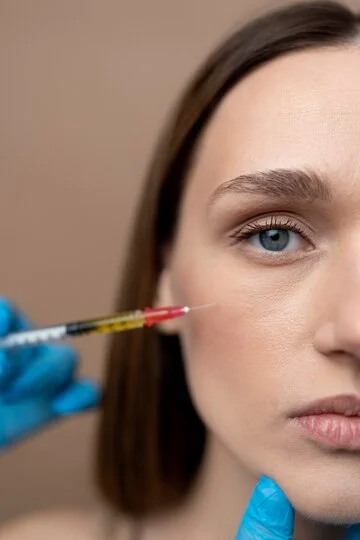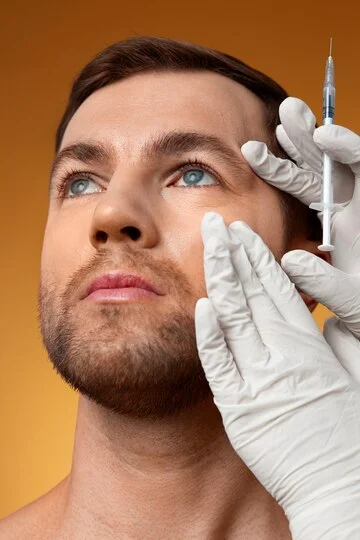Table of Contents
Botox Introduction
Botox, scientifically known as Botulinum Toxin, is a widely used treatment in both cosmetic and medical fields. Derived from the bacterium Clostridium botulinum, it temporarily paralyzes muscles, which has led to its popular use in reducing the appearance of facial wrinkles. However, its applications go far beyond aesthetics, making it an important tool in various medical treatments.

What is Botox (Botulinum Toxin)?
Botulinum toxin is a neurotoxic protein that inhibits the release of acetylcholine, a chemical responsible for muscle contractions. By blocking this chemical, Botox causes temporary muscle relaxation. Though it is a toxin, it is carefully used in small, controlled doses for therapeutic purposes.
Cosmetic Uses of Botox
The most recognized use of Botox is in the cosmetic industry, where it is employed to smooth out wrinkles and fine lines. Here are common areas where Botox is applied:
- Forehead Lines
- Crow’s Feet (lines around the eyes)
- Frown Lines (between the eyebrows)
This treatment is popular because it provides a quick, non-invasive solution to signs of aging, with effects that typically last three to six months.
Medical Uses of Botox
Beyond aesthetics, Botox has significant medical applications:
- Chronic Migraine Relief: Botox injections are FDA-approved for preventing migraines in people who experience headaches 15 or more days a month.
- Excessive Sweating (Hyperhidrosis): Botox can block the nerves that stimulate sweat glands, reducing excessive sweating in areas like the underarms.
- Muscle Spasms and Stiffness: Conditions such as cervical dystonia, which cause abnormal head and neck muscle contractions, can be treated with Botox to relieve muscle stiffness.
- Overactive Bladder: Botox is also used to manage urinary incontinence by relaxing the bladder muscles.
- Lazy Eye (Strabismus): By relaxing certain eye muscles, Botox can help correct misaligned eyes.
How Long Does Botox (Botulinum Toxin)Last?
The effects of Botox generally last between 3 to 6 months, depending on various factors. After this period, muscle activity gradually returns, and wrinkles or lines may start to reappear, although they often become less severe with repeated treatments.
Here’s a breakdown of the factors that influence the longevity of Botox:
1. Treatment Area
- Facial Treatments: Areas like the forehead or crow’s feet around the eyes typically see results lasting around 3 to 4 months.
- Medical Treatments: For conditions like chronic migraines or muscle spasms, the effects of Botox may last closer to the 4-6 month range.
2. Individual Factors
- Metabolism: Some people naturally metabolize the Botulinum Toxin faster, which may cause the effects to wear off sooner.
- Age and Skin Elasticity: Younger individuals with better skin elasticity may find that the effects last a bit longer, while older individuals may experience shorter durations.
- Muscle Activity: Areas with more frequent muscle use, such as around the mouth, might see faster dissipation of Botox’s effects compared to areas with less movement.
3. Botox Dosage
Higher doses of Botox can lead to longer-lasting effects, while smaller doses may wear off more quickly. The precise amount used depends on the treatment area and the desired outcome.
4. Frequency of Treatment
Over time, repeated Botox treatments can help prolong the effects as the muscles weaken and require less frequent injections to maintain the desired results.
When to Schedule Maintenance Treatments
Many people choose to schedule touch-ups every 3-4 months to maintain the smoothness and wrinkle-reducing effects of Botox. For those who use Botox for medical purposes, a similar time frame is usually recommended, but this may vary based on the condition being treated.
Who Should Avoid Botox (Botulinum Toxin)?
Botox may not be suitable for everyone. Individuals with the following conditions should avoid or consult their doctor before treatment:
- Neuromuscular diseases like ALS or Myasthenia Gravis.
- Allergies to any ingredients in Botox.
- Pregnancy or Breastfeeding: The effects of Botox during pregnancy or breastfeeding are not well-researched, so caution is advised.
Botox has revolutionized both cosmetic and medical treatments, offering a temporary solution to various issues, from wrinkles to chronic medical conditions. However, it’s essential to have treatments administered by a qualified professional to avoid complications.
If you’re considering Botox, consult with a certified healthcare provider to discuss whether it’s right for you.
How Does Botox Work?
Botox, or Botulinum Toxin, works by targeting the connection between nerves and muscles. When injected into specific areas, Botox blocks the release of acetylcholine, a neurotransmitter responsible for triggering muscle contractions. By doing so, it temporarily paralyzes or relaxes the muscles in the injected area, producing both cosmetic and medical effects.
Here’s a breakdown of the mechanism:
- Nerve-Muscle Communication: Normally, when your nerves send signals, they release acetylcholine, which binds to receptors on muscles. This triggers the muscle to contract, leading to movement.
- Botox Inhibits Acetylcholine Release: When Botox is injected, it prevents the nerve endings from releasing acetylcholine. This blocks the signal between the nerve and the muscle, causing the muscle to relax or become temporarily paralyzed.
- Relaxed Muscles: The muscle in the treated area becomes less active. For cosmetic purposes, this smooths out wrinkles and fine lines, especially in areas with repetitive facial movements like the forehead, around the eyes, and between the eyebrows. For medical conditions like muscle spasms or overactive bladder, this relaxation reduces the symptoms caused by muscle overactivity.
- Temporary Effect: The effects of Botox are not permanent. Over time, the nerves regenerate their ability to release acetylcholine, and muscle activity gradually returns. This typically happens after 3–6 months, depending on the individual and the dosage.
How Long Does it Take for Botox to Work?
Botox doesn’t produce immediate results. It generally takes 3–7 days for the full effects to become visible, as it takes time for the nerve signals to be blocked and the muscles to relax.
This simple yet powerful mechanism is what makes Botox effective for both aesthetic improvements and treating a range of medical conditions.
What is Botox Made Of?
Botox is derived from Botulinum Toxin, a neurotoxin produced by the bacterium Clostridium botulinum. This bacterium is naturally found in soil, forests, and marine environments, and under certain conditions, it produces the toxin that can cause botulism, a rare but serious illness. However, when used in very small, controlled doses, Botulinum Toxin is safe and has therapeutic applications.
Key Components of Botox (Botulinum Toxin):
- Botulinum Toxin Type A: The active ingredient in Botox is Botulinum Toxin Type A, a purified form of the toxin that blocks nerve signals to muscles. It’s the most commonly used type of Botulinum Toxin in medical and cosmetic treatments.
- Human Albumin: This is a protein derived from human blood plasma. It stabilizes the Botox solution and ensures its effectiveness.
- Sodium Chloride (Salt): This acts as a diluent when preparing the Botox for injection. It’s used to create the solution in which the active toxin is suspended.
How is Botox Made?
To create Botox, scientists take the naturally occurring Botulinum Toxin and purify it under strict laboratory conditions. The final product contains tiny, precisely measured amounts of the toxin that are safe for medical use. The toxin is then mixed with stabilizers like albumin and salt before being distributed for clinical use.
Safety of Botox Ingredients
Although Botulinum Toxin is toxic in large amounts, the highly controlled and purified form used in Botox injections has been proven safe for both medical and cosmetic applications. It’s important to note that Botox treatments should always be administered by a licensed professional to avoid potential risks.
Are There Any Side Effects of Botox?
Yes, while Botox is generally considered safe when administered by a qualified healthcare professional, there are some potential side effects and risks associated with its use. These side effects can range from mild and temporary to more serious, depending on the individual and the specific area of injection.
Common Side Effects of Botox
- Bruising and Swelling: Some redness, swelling, or minor bruising at the injection site is common and usually resolves within a few days.
- Pain or Discomfort: Mild pain or discomfort at the injection site can occur, but this usually subsides shortly after the procedure.
- Headaches: Some people may experience mild headaches following Botox injections, particularly when treating areas like the forehead or around the eyes.
- Flu-Like Symptoms: In rare cases, individuals may feel flu-like symptoms, including fatigue, nausea, or muscle weakness, shortly after treatment.
- Temporary Drooping (Ptosis): Botox can sometimes spread to nearby muscles, causing temporary drooping of the eyelid or brow. This effect is temporary but can last for a few weeks.
- Crooked Smile or Drooling: If Botox spreads to muscles around the mouth, it may cause an asymmetrical smile or temporary drooling.
Rare but Serious Side Effects of Botox
Although rare, more serious side effects can occur, particularly if Botox is improperly administered or the body has an unusual reaction. These may include:
- Muscle Weakness in Areas Beyond the Injection Site: This can occur if the toxin spreads, though this is rare when administered correctly.
- Difficulty Swallowing or Breathing: Botox can affect muscles involved in swallowing or breathing, especially if injected near the neck. This is more common with larger doses used in medical treatments rather than cosmetic applications.
- Vision Problems: Some individuals report blurred vision, double vision, or dry eyes after receiving Botox, particularly around the eyes or forehead.
- Allergic Reactions: While uncommon, some people may develop an allergic reaction to Botox, including itching, rash, or shortness of breath.
- Botulism-like Symptoms: In extremely rare cases, symptoms similar to botulism (such as muscle weakness, difficulty speaking or swallowing, and breathing problems) can occur if the toxin spreads too far from the injection site.
Who is More Likely to Experience Side Effects?
Certain individuals may be at a higher risk of experiencing side effects from Botox, including:
- Those with neuromuscular disorders (e.g., Myasthenia Gravis or ALS).
- Pregnant or breastfeeding women (Botox’s effects during pregnancy are not well-researched).
- Individuals with allergies to any of Botox’s ingredients.
Minimizing the Risk of Side Effects
To reduce the risk of side effects, it’s essential to:
- Ensure the Botox is administered by a certified professional with experience in injections.
- Follow post-treatment instructions carefully, such as avoiding strenuous activity or lying down immediately after the procedure.
- Consult your doctor if you have any pre-existing conditions that may increase the risk of side effects.
Botox is a widely used treatment with a good safety profile when administered correctly. However, it is important to be aware of potential side effects and choose a licensed professional for the procedure. If any unusual or severe side effects occur, seeking medical attention promptly is recommended.
Botox FAQ: Duration, Uses, Benefits, and Risks
1. How long does Botox last?
The effects of Botox typically last between 3 to 6 months. The duration can vary based on factors such as the treatment area, individual metabolism, age, and muscle activity. For cosmetic treatments like reducing wrinkles, the effects generally last 3 to 4 months. For medical conditions, such as chronic migraines or muscle spasms, the effects usually persist for 4 to 6 months.
2. What are the common uses of Botox?
Botox is used for both cosmetic and medical purposes:
- Cosmetic Uses: To smooth dynamic wrinkles such as frown lines, crow’s feet, and forehead lines.
- Medical Uses: To treat conditions like chronic migraines, excessive sweating (hyperhidrosis), overactive bladder, and muscle spasms.
3. What are the benefits of Botox?
- Non-Surgical: Offers a non-invasive alternative to cosmetic surgery.
- Quick Treatment: Procedures are typically quick, with minimal downtime.
- Effective: Proven to be effective for both cosmetic and medical applications.
- Customizable: Treatments can be tailored to individual needs and desired outcomes.
4. Are there any risks or side effects associated with Botox?
While Botox is generally safe, potential risks and side effects include:
- Temporary Side Effects: Such as bruising, redness, or swelling at the injection site. Some people may also experience headaches or temporary drooping of the eyelids.
- Allergic Reactions: Rarely, allergic reactions may occur, presenting as itching, rash, or difficulty breathing.
- Asymmetry or Unintended Effects: Risk of asymmetry or unintended muscle paralysis if the Botox spreads to nearby muscles. Selecting an experienced provider can reduce this risk.
5. How often do I need Botox treatments?
To maintain the effects of Botox, treatments are typically required every 3 to 6 months. The frequency depends on the individual’s response to the treatment and the specific area being treated.
6. Can I resume normal activities after a Botox treatment?
Yes, most patients can return to their regular activities almost immediately after a Botox treatment. It is advisable to avoid strenuous exercise and massaging the treated area for a few hours to minimize potential side effects.
7. What should I expect after my Botox treatment?
After treatment, you may experience mild bruising, redness, or swelling at the injection site. These side effects are usually temporary and subside within a few days. Full results typically become visible within 3 to 5 days.
8. Is Botox treatment painful?
Botox injections are generally well-tolerated. The procedure involves small needle pricks, which some patients describe as minimally uncomfortable. A local anesthetic or numbing cream can be applied if desired.
9. How can I ensure the best results from Botox?
To achieve optimal results, choose a qualified and experienced healthcare provider. Following pre- and post-treatment care instructions and discussing your goals and concerns with your provider will also help ensure the best outcomes.
10. Are there any alternatives to Botox?
Yes, there are several alternatives to Botox, including Dysport, Xeomin, and Jeuveau. Each has its own formulation and may be better suited for different needs or preferences. Consult with your healthcare provider to determine which option is best for you.
Conclusion: Botox Duration,
Botox has established itself as a prominent solution for both cosmetic and medical purposes. Understanding how long Botox lasts, its uses, benefits, and potential risks can help individuals make informed decisions about their treatment options.
The effects of Botox typically last between 3 to 6 months. This duration can vary based on several factors, including the treatment area, individual metabolism, age, and muscle activity. For cosmetic uses, such as reducing wrinkles on the forehead or around the eyes, the effects generally persist for about 3 to 4 months. In contrast, Botox treatments for medical conditions, like chronic migraines or muscle spasms, often last closer to 4 to 6 months. Regular maintenance treatments are usually required to sustain the desired results.
In conlusion, Botox offers a valuable solution for both cosmetic and medical concerns, with effects that typically last between 3 to 6 months. Its non-surgical nature, quick treatment time, and proven efficacy make it a popular choice for reducing wrinkles and managing certain medical conditions. However, as with any medical treatment, understanding the potential risks and side effects is essential for making an informed decision. Consulting with a qualified healthcare provider can ensure that Botox is administered safely and effectively, maximizing benefits while minimizing potential risks. Read more about your skin

